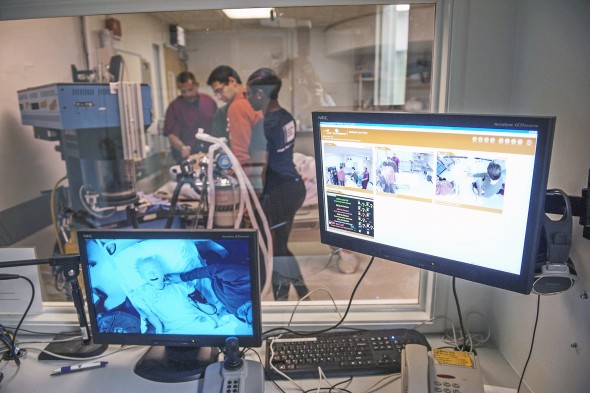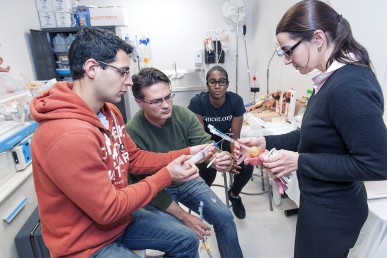Clinical Performance Center sets the stage for medical careers

Anesthesiology residents train in the Clinical Performance Center. Technicians in the control room operate the mannequins to respond to treatment. Photo: Roberta Dupuis-Devlin/UIC News
Walking around the College of Medicine’s Clinical Performance Center is a little like walking around a stage set for a hospital. There are clinical exam rooms, actor “patients” and lots of props, including fake blood hanging on IV poles.
In a way, the Dr. Allan L. and Mary L. Graham Clinical Performance Center is exactly that — an artificial medical setting where students can practice and perfect clinical skills like drawing blood, taking patient histories, listening to heart sounds and doing spinal taps, before they get to their first real patients.
“We want the students to get through the steep part of the learning curve here,” said Rachel Yudkowsky, the center’s director.
In 2012, more than 2,000 learners used the Clinical Performance Center, putting in roughly 30,000 hours there. The center, running at full capacity because its facilities are in high demand, is outgrowing its space on the first floor of the Medical Sciences Building.
By summer 2016 the center will have a new home, twice the size, on the fourth floor of the Mile Square Health Center.

Anesthesiology residents Karmin Nissan, Francesco Vetri and Corrie Burke work with Heike Knorpp, assistant professor of anesthesiology in the Clinical Performance Center. Photo: Roberta Dupuis-Devlin/UIC Photo Services
Last month the University of Illinois Board of Trustees approved $7 million for the project from the restricted funds operating budget of the College of Medicine at Chicago. The money will go towards building out the floor, now a large, open, unoccupied space, with mechanical, electrical and plumbing infrastructure, new furniture, and new audio visual and simulation equipment. Plans are being drafted for more and larger patient rooms, classrooms and additional in-patient rooms to accommodate new full-body medical mannequins.
“We’d like to have bigger exam rooms where we can have a child patient together with the mother, so that our medical students can practice communicating with a frightened parent around a medical scenario,” said Yudkowsky.
Larger patient rooms will mean medical and nursing students can participate in exercises with standardized patients together. “In the real world, doctors and nurses need to communicate in order to deliver patient care, but get little practice in doing so until they are faced with real patients. Their training is very siloed and there are few opportunities for medical and nursing students to learn together.”
In its current location, the center has 16 patient exam rooms where students interview actors, called standardized patients, who are trained to describe the symptoms of ailments ranging from depression to diabetes. The “patients” respond to their student-physician’s questions, adding complications like communication challenges or underlying psychological issues. After the encounter, the standardized patient gives feedback — a unique opportunity for the students to find out what it feels like to be their patient.
“Students can practice having uncomfortable or difficult conversations with our standardized patients,” said Yudkowsky. “It takes practice to develop the needed skill and confidence in dealing with the interpersonal aspects of practicing medicine, so this is a very important arena for building those techniques.”
In two in-patient rooms, full-body mannequins lie on hospital beds hooked up to vital-sign monitors. In adjacent control rooms that look into the hospital room through a one-way mirror, technicians can control the mannequins to respond realistically to what the students are doing.
If a student gives the wrong dose of medication, the mannequin may show abnormal signals on the heart monitor or respond with rapid, shallow breathing. The students, acting as a team, must work to rescue the patient. Instructors and fellow students in the debriefing room watch on video to provide feedback and discuss alternative approaches.
The center has mannequin arms that students can use to practice skills like suturing or inserting needles for blood draws. Torsos are used to practice lumbar punctures.
Medical students visit the center in their first year to practice taking histories and doing basic medical exams on standardized patients. They return throughout the next three years to practice procedural skills. Their final exam includes performing 12 clinical skills and six standardized patient encounters.
UI Hospital medical residents, who come from all around the country, are put through their paces in the Clinical Performance Center on a range of standard procedures before they go out on the hospital floor. If any deficiencies are noticed, the center trains them on those skills.
Yudkowsky looks forward to the new facility. “Simulation has become an essential part of health professions education,” she said. “An expanded simulation center at Mile Square will allow us to provide new and innovative programs for our students and residents, and ultimately help improve patient care.”
Categories
Patient Care, Students, UI Hospital
Topics
Clinical Performance Center, medical education, medical training
